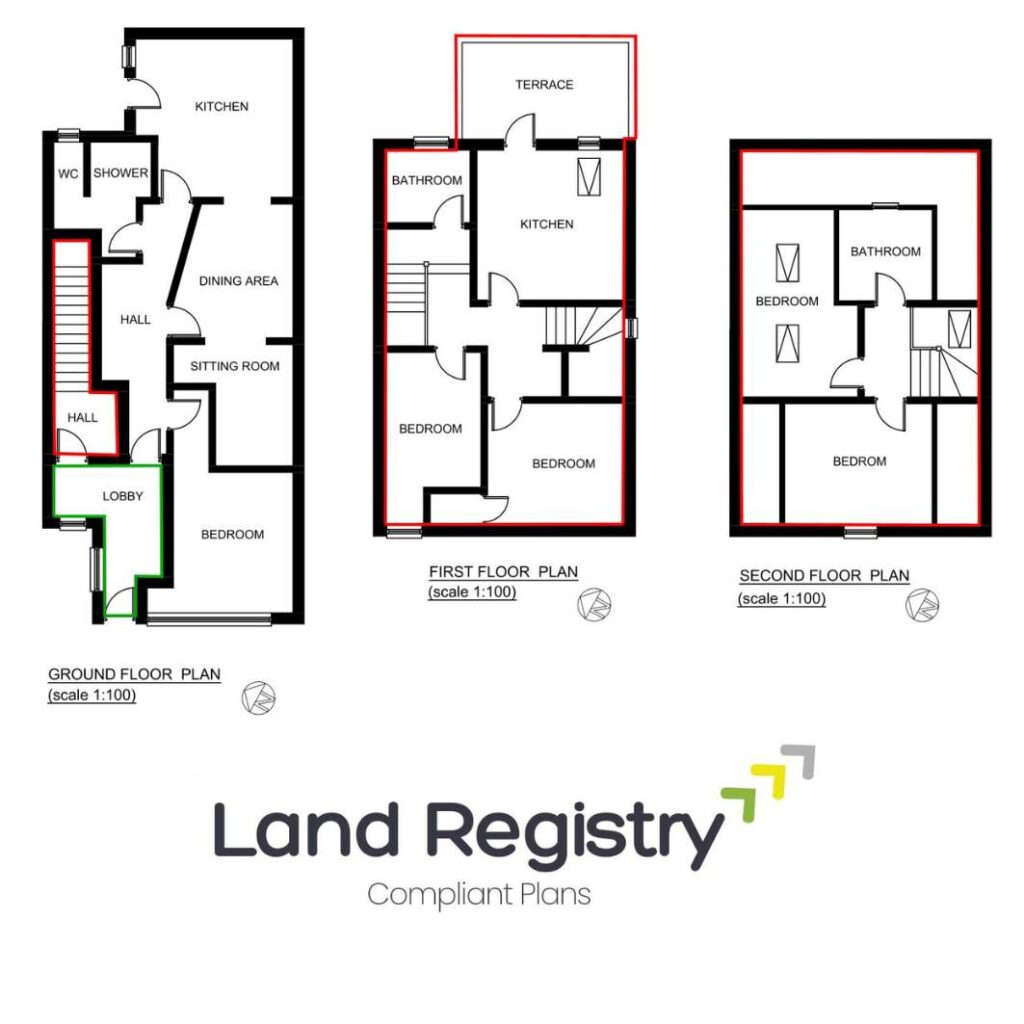The Land Registry Hub: Your Go-To Guide for Property Plans & Conveyancing
🛠️ Navigating the world of Land Registry, lease plans, title plans, and conveyancing can feel like a legal maze—but don’t worry, we’ve got you covered! Whether you’re a property owner, landlord, solicitor, or just someone trying to make sense of UK property rules, this blog is your one-stop resource for clear, practical advice.
From understanding lease plans to avoiding common conveyancing pitfalls, we break it all down in a way that’s easy to follow. Stay tuned for expert insights, tips, and updates to keep you ahead in the property game! 🏡📜✨

Land Registry Compliant Plans
Understanding the Role of HM Land Registry in UK Property Ownership
If you own property in the UK—or you’re planning to buy, sell, or lease—you’ve probably come across HM Land Registry (HMLR). But what exactly does it do, and why is it so important?
In simple terms, HM Land Registry is the official record keeper of all property and land ownership in England and Wales. It ensures that ownership rights are legally documented and protected, helping to prevent disputes, fraud, and confusion over who owns what.
In this guide, we’ll break down what HM Land Registry does, why it matters, and how to use its services effectively.
What is HM Land Registry?
HM Land Registry is a government department that:
✅ Registers property and land ownership
✅ Keeps records of sales, leases, and mortgages
✅ Provides proof of ownership through Title Registers and Title Plans
✅ Helps resolve boundary disputes and legal issues
✅ Protects owners from property fraud
📌 Did you know? HM Land Registry holds records for over 87% of land in England and Wales, with the goal of registering 100% of properties in the near future.
Why is Land Registration Important?
Before HM Land Registry existed, property ownership relied on paper deeds, which could be lost, stolen, or forged. Today, having land and property officially registered brings several benefits:
🏡 Proof of Ownership – Your name is legally recorded as the owner.
🔍 Prevents Disputes – Title Plans clearly show property boundaries.
💰 Simplifies Buying & Selling – Buyers and mortgage lenders can quickly verify ownership details.
🚫 Protects Against Fraud – Registration makes it harder for scammers to sell or mortgage a property they don’t own.
💡 If your property isn’t registered, you should consider doing it now to protect your ownership rights.
What Does HM Land Registry Record?
When you buy or lease a property, HM Land Registry creates two key documents:
1️⃣ Title Register 📜
The Title Register is an official document that includes:
✔️ The owner’s name(s)
✔️ The price paid (if bought after 2000)
✔️ Any mortgages or legal charges on the property
✔️ Covenants or restrictions on use (e.g., no commercial use)
✔️ Rights of way, easements, or leasehold terms
💡 How to get it: You can download a Title Register for any property for £3 from the HM Land Registry website.
2️⃣ Title Plan 🗺
The Title Plan is a map showing:
✔️ The general boundaries of the property (outlined in red)
✔️ Adjacent properties and land features
✔️ Rights of way or shared access points
🚨 Important: Title Plans only show general boundaries, not precise legal boundary lines. If you need exact measurements, you may require a boundary survey or a determined boundary application.
When Do You Need to Interact with HM Land Registry?
You may need to contact HM Land Registry if you are:
🏡 Buying a property – The property must be registered in your name after purchase.
📜 Selling a property – Buyers will check the Title Register and Plan before purchasing.
🔍 Checking property details – You can access ownership records, past sales, and mortgage information.
🏠 Leasing a property for more than 7 years – You’ll need to register the lease and provide a Lease Plan.
📏 Resolving a boundary dispute – You may need to apply for a Determined Boundary Plan.
🚫 Protecting against property fraud – You can set up property alerts to prevent unauthorised transactions.
How to Use HM Land Registry’s Services
💻 Most services are available online via gov.uk. Here’s what you can do:
📌 Check Property Ownership – Download a Title Register (£3)
📌 View a Property’s Boundaries – Get a Title Plan (£3)
📌 Search for Past Sales Prices – View the Property Sales Register
📌 Register a Lease or Transfer of Ownership – Submit forms online or via a solicitor
📌 Apply for a Boundary Dispute Resolution – Use Form DB (Determined Boundary Application)
📌 Set Up a Property Fraud Alert – Get notified if someone tries to make changes to your registered property
🚀 Tip: If you’re unsure how to submit an application, a solicitor or conveyancer can handle it for you.
What If Your Property Isn’t Registered?
If your property has never been registered, you should consider voluntary registration.
📌 How to register an unregistered property:
1️⃣ Gather your original deeds and proof of ownership.
2️⃣ Complete Form FR1 (First Registration Application).
3️⃣ Submit the form to HM Land Registry with the registration fee (varies by property value).
💰 Cost: Fees range from £30 (for properties under £80,000) to £910 (for properties over £1 million).
🚨 Why register? If your property isn’t registered, it’s harder to prove ownership, and you may be at higher risk of fraud.
Common Land Registry Issues (and How to Fix Them)
🚨 Issue 1: Incorrect Property Boundaries
❌ Problem: Your Title Plan doesn’t match your physical boundaries.
✔️ Solution: Apply for a Determined Boundary (Form DB) and provide evidence (survey reports, photos).
🚨 Issue 2: Disputed Rights of Way
❌ Problem: A shared driveway or access route isn’t correctly recorded.
✔️ Solution: Apply for an easement update and gather legal proof.
🚨 Issue 3: Property Fraud Risk
❌ Problem: Someone tries to change ownership without your consent.
✔️ Solution: Set up Land Registry property alerts and use a restriction application to prevent unauthorised transactions.
🚨 Issue 4: Unregistered Property Causing Delays in a Sale
❌ Problem: Your property is unregistered, and buyers want proof of ownership.
✔️ Solution: Apply for first registration ASAP to avoid legal complications.
Final Thoughts: Why HM Land Registry Matters
HM Land Registry plays a crucial role in protecting property ownership, preventing fraud, and making buying, selling, and leasing property more transparent.
✅ If you’re buying a property – Check the Title Register & Plan before making an offer.
✅ If you’re selling a property – Ensure your ownership records are correct and that your Lease Plan is Land Registry-compliant.
✅ If you’re dealing with a boundary dispute – Use official Land Registry records as evidence.
✅ If your property is unregistered – Consider registering it voluntarily to secure your ownership rights.
💬 Got a question about Land Registry services? Drop it in the comments—we’re happy to help! 🏡📜
Contact Us
Call Us : 01375 267 277
We are open from Monday to Friday
08.30 AM - 17.30 PM
Surv Essex Limited
Building 13 Thames Enterprise Centre
Princess Margaret Road
East Tilbury
RM18 8RH
Our Services
- Lease Plans
- Title Plans
- Conveyancing Plans
- Licencing Plans
- Retail Plans
Quick Links
- Home
- About Us
- Pricing Plan
- Team
- Blog
- Privacy Policy
- Terms & Service

